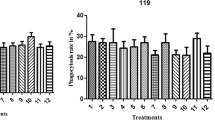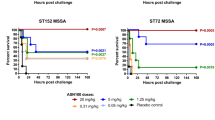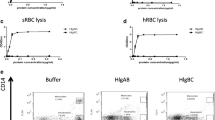Abstract
The response to treatment of severe methicillin-resistant Staphylococcus aureus (MRSA) infections with the traditional antibiotics is sometimes unsatisfactory and multiple antibiotic resistance is common. Adjuvant therapy such as intravenous immunoglobulin G (IVIG) could possibly be helpful in the treatment of such infections. The effect of IVIG on the capacity of human neutrophils to phagocytose and kill MRSA was investigated in vitro using the MTT assay and measuring the production of reactive oxygen species (ROS) and nitric oxide (NO). The efficiency of IVIG in neutralizing α-hemolysin and coagulase of MRSA was also assessed. The capability of IVIG in the treatment and prevention of MRSA infections was also evaluated in a murine peritonitis model. IVIG significantly enhanced (p < 0.01) the killing of MRSA by neutrophils at all concentrations tested (0.1–5 mg/ml) by 30–80 % of control values. It significantly (p < 0.01) increased the level of NO production in a dose-dependent manner, giving up to 60 μM at 5 mg/ml. The ROS level significantly increased (p < 0.01) in the presence of IVIG. In addition, IVIG significantly reduced the hemolytic activity of MRSA 10-fold and its coagulation capabilities by 50 %. When tested in vivo, groups receiving IVIG via tail vein infusion showed no significant improvement in their survival. Only when delivered to the same site of infection did IVIG show an improvement in the survival of mice (n = 80). These results could pave the way for a better understanding of the mechanism of action of IVIG and suggest its clinical potential as an adjuvant preventive and therapeutic agent against life-threatening infections caused by MRSA and other bacteria.








Similar content being viewed by others
References
Rossi F, Bellon B, Vial MC, Druet P, Kazatchkine MD (1991) Beneficial effect of human therapeutic intravenous immunoglobulins (IVIg) in mercuric-chloride-induced autoimmune disease of Brown-Norway rats. Clin Exp Immunol 84(1):129–133
El-Azhary R (2005) Intravenous immunoglobulin in dermatology. Egypt Wom Dermatol 2(2):4
Misra N, Bayary J, Dasgupta S, Ephrem A, Huyen JP, Delignat S, Hassan G, Caligiuri G, Nicoletti A, Lacroix-Desmazes S, Kazatchkine MD, Kaveri SV (2005) Intravenous immunoglobulin and dendritic cells. Clin Rev Allergy Immunol 29(3):201–205
Unkeless JC, Shen Z, Lin CW, DeBeus E (1995) Function of human Fc gamma RIIA and Fc gamma RIIIB. Semin Immunol 7(1):37–44
Laupland KB, Kirkpatrick AW, Delaney A (2007) Polyclonal intravenous immunoglobulin for the treatment of severe sepsis and septic shock in critically ill adults: a systematic review and meta-analysis. Crit Care Med 35(12):2686–2692. doi:10.1097/01.CCM.0000295312.13466.1C
Bittner D, Enk A (2008) Intravenous immunoglobulins. In: Gaspari AA, Tyring SK (eds) Clinical and basic immunodermatology, vol 3. Springer London, London, pp 605–614
Späth PJ (1999) Structure and function of immunoglobulins. Sepsis 3(3):197–218
Ishii N, Hashimoto T, Zillikens D, Ludwig RJ (2009) High-dose intravenous immunoglobulin (IVIG) therapy in autoimmune skin blistering diseases. Clin Rev Allergy Immunol 38(2–3):186–195. doi:10.1007/s12016-009-8153-y
Peterlana D, Puccetti A, Simeoni S, Tinazzi E, Corrocher R, Lunardi C (2005) Efficacy of intravenous immunoglobulin in chronic idiopathic pericarditis: report of four cases. Clin Rheumatol 24(1):18–21. doi:10.1007/s10067-004-0959-7
Barekzi NA, Felts AG, Poelstra KA, Slunt JB, Grainger DW (2002) Locally delivered polyclonal antibodies potentiate intravenous antibiotic efficacy against gram-negative infections. Pharm Res 19(12):1801–1807
Norrby-Teglund A, Kaul R, Low DE, McGeer A, Andersson J, Andersson U, Kotb M (1996) Evidence for the presence of streptococcal-superantigen-neutralizing antibodies in normal polyspecific immunoglobulin G. Infect Immun 64(12):5395–5398
Darenberg J, Söderquist B, Normark BH, Norrby-Teglund A (2004) Differences in potency of intravenous polyspecific immunoglobulin G against streptococcal and staphylococcal superantigens: implications for therapy of toxic shock syndrome. Clin Infect Dis 38(6):836–842. doi:10.1086/381979
Orange JS, Hossny EM, Weiler CR, Ballow M, Berger M, Bonilla FA, Buckley R, Chinen J, El-Gamal Y, Mazer BD, Nelson RP Jr, Patel DD, Secord E, Sorensen RU, Wasserman RL, Cunningham-Rundles C; Primary Immunodeficiency Committee of the American Academy of Allergy, Asthma and Immunology (2006) Use of intravenous immunoglobulin in human disease: a review of evidence by members of the Primary Immunodeficiency Committee of the American Academy of Allergy, Asthma and Immunology. J Allergy Clin Immunol 117(4 Suppl):S525–S553. doi:10.1016/j.jaci.2006.01.015
DeLeo FR, Otto M (2008) An antidote for Staphylococcus aureus pneumonia? J Exp Med 205(2):271–274. doi:10.1084/jem.20080167
Noto MJ, Fox PM, Archer GL (2008) Spontaneous deletion of the methicillin resistance determinant, mecA, partially compensates for the fitness cost associated with high-level vancomycin resistance in Staphylococcus aureus. Antimicrob Agents Chemother 52(4):1221–1229. doi:10.1128/AAC.01164-07
Matouskova I, Janout V (2008) Current knowledge of methicillin-resistant Staphylococcus aureus and community-associated methicillin-resistant Staphylococcus aureus. Biomed Pap Med Fac Univ Palacky Olomouc Czech Repub 152(2):191–202
Goldstein F, Perutka J, Cuirolo A, Plata K, Faccone D, Morris J, Sournia A, Kitzis MD, Ly A, Archer G, Rosato AE (2007) Identification and phenotypic characterization of a beta-lactam-dependent, methicillin-resistant Staphylococcus aureus strain. Antimicrob Agents Chemother 51(7):2514–2522. doi:10.1128/AAC.00040-07
Memmi G, Filipe SR, Pinho MG, Fu Z, Cheung A (2008) Staphylococcus aureus PBP4 is essential for beta-lactam resistance in community-acquired methicillin-resistant strains. Antimicrob Agents Chemother 52(11):3955–3966. doi:10.1128/AAC.00049-08
D’Agata EM, Webb GF, Horn MA, Moellering RC Jr, Ruan S (2009) Modeling the invasion of community-acquired methicillin-resistant Staphylococcus aureus into hospitals. Clin Infect Dis 48(3):274–284
Nguyen HM, Graber CJ (2010) Limitations of antibiotic options for invasive infections caused by methicillin-resistant Staphylococcus aureus: is combination therapy the answer? J Antimicrob Chemother 65(1):24–36. doi:10.1093/jac/dkp377
Dalla Valle C, Pasca MR, De Vitis D, Marzani FC, Emmi V, Marone P (2009) Control of MRSA infection and colonisation in an intensive care unit by GeneOhm MRSA assay and culture methods. BMC Infect Dis 9:137. doi:10.1186/1471-2334-9-137
Han G, Martinez LR, Mihu MR, Friedman AJ, Friedman JM, Nosanchuk JD (2009) Nitric oxide releasing nanoparticles are therapeutic for Staphylococcus aureus abscesses in a murine model of infection. PLoS One 4(11):e7804. doi:10.1371/journal.pone.0007804
Behera B, Das A, Mathur P, Kapil A, Gadepalli R, Dhawan B (2009) Tigecycline susceptibility report from an Indian tertiary care hospital. Indian J Med Res 129(4):446–450
Henson PM, Oades ZG (1975) Stimulation of human neutrophils by soluble and insoluble immunoglobulin aggregates. Secretion of granule constituents and increased oxidation of glucose. J Clin Invest 56(4):1053–1061. doi:10.1172/JCI108152
Foster TJ (2005) Immune evasion by staphylococci. Nat Rev Microbiol 3(12):948–958. doi:10.1038/nrmicro1289
Palazzolo-Ballance AM, Reniere ML, Braughton KR, Sturdevant DE, Otto M, Kreiswirth BN, Skaar EP, DeLeo FR (2008) Neutrophil microbicides induce a pathogen survival response in community-associated methicillin-resistant Staphylococcus aureus. J Immunol 180(1):500–509
Li M, Cha DJ, Lai Y, Villaruz AE, Sturdevant DE, Otto M (2007) The antimicrobial peptide-sensing system aps of Staphylococcus aureus. Mol Microbiol 66(5):1136–1147. doi:10.1111/j.1365-2958.2007.05986.x
Sharma A, Tripathi AK, Kalra OP, Chakrabarty AK (2000) Impaired function of neutrophils in uraemic patients. Natl Med J India 13(3):121–124
Winterbourn CC, Hampton MB, Livesey JH, Kettle AJ (2006) Modeling the reactions of superoxide and myeloperoxidase in the neutrophil phagosome: implications for microbial killing. J Biol Chem 281(52):39860–39869. doi:10.1074/jbc.M605898200
Sahoo G, More T, Singh VK (2000) Evaluation of oxygen-dependent immunodefences of the polymorphonuclear cells of some tropical ruminants. Vet Res Commun 24(8):505–515
Wheeler MA, Smith SD, García-Cardeña G, Nathan CF, Weiss RM, Sessa WC (1997) Bacterial infection induces nitric oxide synthase in human neutrophils. J Clin Invest 99(1):110–116. doi:10.1172/JCI119121
Mastroeni P, Vazquez-Torres A, Fang FC, Xu Y, Khan S, Hormaeche CE, Dougan G (2000) Antimicrobial actions of the NADPH phagocyte oxidase and inducible nitric oxide synthase in experimental salmonellosis. II. Effects on microbial proliferation and host survival in vivo. J Exp Med 192(2):237–248
Montgomery RR, Lusitani D, de Boisfleury Chevance A, Malawista SE (2002) Human phagocytic cells in the early innate immune response to Borrelia burgdorferi. J Infect Dis 185(12):1773–1779. doi:10.1086/340826
Geller DA, Billiar TR (1998) Molecular biology of nitric oxide synthases. Cancer Metastasis Rev 17(1):7–23
Allen RC (1977) Evaluation of serum opsonic capacity by quantitating the initial chemiluminescent response from phagocytizing polymorphonuclear leukocytes. Infect Immun 15(3):828–833
Easmon CS, Cole PJ, Williams AJ, Hastings M (1980) The measurement of opsonic and phagocytic function by Luminol-dependent chemiluminescence. Immunology 41(1):67–74
Ono Y, Ito T, Watanabe T, Koshio O, Tansho S, Ikeda T, Kawakami S, Miyazawa Y (2004) Opsonic activity assessment of human intravenous immunoglobulin preparations against drug-resistant bacteria. J Infect Chemother 10(4):234–238. doi:10.1007/s10156-004-0325-3
Bubeck Wardenburg J, Schneewind O (2008) Vaccine protection against Staphylococcus aureus pneumonia. J Exp Med 205(2):287–294. doi:10.1084/jem.20072208
Yanagisawa C, Hanaki H, Natae T, Sunakawa K (2007) Neutralization of staphylococcal exotoxins in vitro by human-origin intravenous immunoglobulin. J Infect Chemother 13(6):368–372. doi:10.1007/s10156-007-0551-6
Aarestrup F. M. SNL, Sordillo L. M. (1994) Ability of Staphylococcus aureus coagulase genotypes to resist neutrophil bactericidal activity and phagocytosis. Infect Immun 62(12):5679–5682
Lotsu DK, Imamura T, Takamine F (1995) Current status of antimicrobial susceptibility in MRSA isolates typed by coagulase and phage typing in Okinawa. Acta Med Okayama 49(2):81–89
Jonsson P, Lindberg M, Haraldsson I, Wadström T (1985) Virulence of Staphylococcus aureus in a mouse mastitis model: studies of alpha hemolysin, coagulase, and protein A as possible virulence determinants with protoplast fusion and gene cloning. Infect Immun 49(3):765–769
Werdan K, Pilz G (1996) Supplemental immune globulins in sepsis: a critical appraisal. Clin Exp Immunol 104(Suppl 1):83–90
Cross AS (1995) Intravenous immunoglobins (IVIGs) to prevent and treat infectious diseases. Adv Exp Med Biol 383:123–130
Douzinas EE, Pitaridis MT, Louris G, Andrianakis I, Katsouyanni K, Karmpaliotis D, Economidou J, Syfras D, Roussos C (2000) Prevention of infection in multiple trauma patients by high-dose intravenous immunoglobulins. Crit Care Med 28(1):8–15
Werdan K (2001) Intravenous immunoglobulin for prophylaxis and therapy of sepsis. Curr Opin Crit Care 7(5):354–361
Sriskandan S, Ferguson M, Elliot V, Faulkner L, Cohen J (2006) Human intravenous immunoglobulin for experimental streptococcal toxic shock: bacterial clearance and modulation of inflammation. J Antimicrob Chemother 58(1):117–124. doi:10.1093/jac/dkl173
Weisman LE, Lorenzetti PM (1989) High intravenous doses of human immune globulin suppress neonatal group B streptococcal immunity in rats. J Pediatr 115(3):445–450
Conflict of interest
The authors declare that they have no conflict of interest.
Author information
Authors and Affiliations
Corresponding author
Rights and permissions
About this article
Cite this article
Farag, N., Mahran, L., Abou-Aisha, K. et al. Assessment of the efficacy of polyclonal intravenous immunoglobulin G (IVIG) against the infectivity of clinical isolates of methicillin-resistant Staphylococcus aureus (MRSA) in vitro and in vivo. Eur J Clin Microbiol Infect Dis 32, 1149–1160 (2013). https://doi.org/10.1007/s10096-013-1861-5
Received:
Accepted:
Published:
Issue Date:
DOI: https://doi.org/10.1007/s10096-013-1861-5




